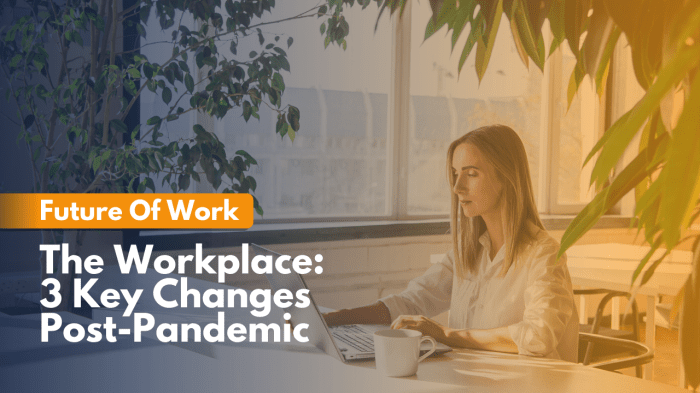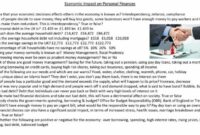The future of work and its impact on modern living are transforming how we live, work, and interact. From the rise of remote work and the gig economy to the increasing automation of tasks, the landscape of employment is undergoing a dramatic shift. This evolution presents both incredible opportunities and significant challenges, requiring adaptation, innovation, and a re-evaluation of our societal structures.
Understanding these changes is crucial for navigating the complexities of the modern world and preparing for what lies ahead.
This exploration delves into the emerging job sectors, the decline of traditional industries, and the skills gap that’s developing. We’ll examine the advantages and disadvantages of remote work, the implications of automation and artificial intelligence, and the ethical considerations surrounding their implementation. Furthermore, we’ll discuss the gig economy’s impact, the importance of lifelong learning, and how these changes are reshaping family life, social structures, and our overall well-being.
Remote Work and its Implications
The rise of remote work has fundamentally reshaped the modern workplace, impacting both employers and employees in profound ways. This shift, accelerated by recent global events, presents a complex landscape of advantages and disadvantages, requiring careful consideration and strategic adaptation. Understanding these implications is crucial for navigating the future of work effectively.Remote work offers significant benefits for both sides of the employment equation.
However, it also presents unique challenges that need to be addressed proactively to ensure its long-term success and sustainability.
Advantages and Disadvantages of Remote Work
For employees, remote work often translates to improved work-life balance through flexible schedules and the elimination of commuting time. This can lead to reduced stress and increased job satisfaction. However, the blurring of boundaries between work and personal life can also lead to overwork and feelings of isolation. Employers benefit from access to a wider talent pool, reduced overhead costs associated with office space, and potentially increased employee productivity (when managed effectively).
Conversely, challenges include maintaining team cohesion, ensuring effective communication, and monitoring employee performance in a decentralized environment. The success of remote work depends heavily on clear communication, trust, and the establishment of robust processes and technologies.
Managing Remote Teams: Challenges and Solutions
Managing remote teams presents unique challenges. Communication breakdowns, lack of team cohesion, and difficulty in monitoring progress are common issues. To mitigate these challenges, organizations need to invest in robust communication tools and establish clear expectations and performance metrics. Regular virtual team meetings, utilizing video conferencing for enhanced engagement, are crucial. Furthermore, fostering a strong team culture through virtual social events and informal communication channels can help combat feelings of isolation.
Clear guidelines for communication protocols, project management methodologies, and performance evaluations are essential for maintaining productivity and accountability. For example, implementing project management software with clear task assignments and progress tracking can significantly improve team coordination and efficiency.
Maintaining Work-Life Balance in Remote Work
Maintaining a healthy work-life balance while working remotely is paramount for employee well-being and long-term productivity. The lack of physical separation between work and home can easily lead to overwork and burnout. Establishing clear boundaries between work and personal time is crucial. This might involve setting specific work hours, designating a dedicated workspace, and actively disconnecting after work hours.
Regular breaks, exercise, and prioritizing personal time are essential for preventing burnout. Open communication with supervisors about workload and personal needs is also important. Employers can support this by promoting a culture that values work-life balance and encourages employees to take breaks and utilize their vacation time.
Tools and Technologies for Effective Remote Collaboration
Effective remote collaboration relies heavily on the right tools and technologies. A robust technology infrastructure is essential for seamless communication and efficient workflow.
- Video conferencing platforms: Zoom, Google Meet, Microsoft Teams – facilitating real-time interaction and collaboration.
- Project management software: Asana, Trello, Monday.com – enabling task assignment, progress tracking, and team communication.
- Instant messaging platforms: Slack, Microsoft Teams – providing quick and easy communication channels for informal updates and quick questions.
- Cloud storage and collaboration tools: Google Drive, Dropbox, Microsoft OneDrive – allowing for easy file sharing and collaborative document editing.
- Virtual Private Networks (VPNs): Ensuring secure access to company networks and data from remote locations.
Automation and Artificial Intelligence

Source: allwork.space
The rise of automation and artificial intelligence (AI) is fundamentally reshaping the future of work, impacting various industries and demanding a proactive approach to its societal implications. This technological shift presents both immense opportunities for increased efficiency and productivity, alongside significant challenges related to job displacement and ethical considerations.Automation’s Impact on Industries and Job RolesAutomation, driven by advancements in robotics, machine learning, and data analytics, is rapidly transforming industries.
Manufacturing, for example, has seen widespread adoption of robotic systems for assembly lines, leading to increased output and reduced labor costs. Similarly, the transportation sector is experiencing disruption with the development of self-driving vehicles, potentially impacting the jobs of truck drivers, taxi drivers, and delivery personnel. The finance industry utilizes AI-powered algorithms for fraud detection and risk assessment, automating tasks previously performed by human analysts.
The future of work is rapidly changing, impacting how we live and interact. Blurred lines between professional and personal lives are increasingly common, making it crucial to find a healthy equilibrium. For practical tips on navigating this challenge, check out this helpful guide on how to balance work life and social life in modern society. Mastering this balance will be key to thriving in the evolving landscape of modern work and its demands on our personal time.
These changes are not limited to blue-collar jobs; white-collar professions like accounting, legal research, and even parts of software development are seeing automation of routine tasks.
Potential Worker Displacement and Mitigation Strategies
The automation of tasks previously performed by humans inevitably leads to concerns about job displacement. While some argue that new jobs will be created to offset this, the transition period can be difficult for workers who lack the skills needed for the emerging roles. To mitigate this, proactive strategies are crucial. These include investing in education and retraining programs to equip workers with the skills needed for jobs in emerging fields like data science, AI development, and cybersecurity.
Government policies focusing on social safety nets, such as unemployment benefits and job placement services, can also provide crucial support during transitions. Furthermore, focusing on reskilling initiatives within companies, allowing employees to adapt to changing roles, can help to lessen the impact of automation. For example, a manufacturing company might train its assembly line workers to operate and maintain robotic systems, rather than simply replacing them entirely.
AI Applications Transforming the Workplace
AI is not just automating existing tasks; it’s also creating entirely new possibilities. AI-powered chatbots are improving customer service by providing instant support and answering frequently asked questions. In healthcare, AI algorithms are assisting in disease diagnosis and treatment planning, analyzing medical images with greater speed and accuracy than human doctors alone. In human resources, AI is being used to streamline recruitment processes, analyze resumes, and even predict employee turnover.
These applications not only increase efficiency but also enhance decision-making by providing data-driven insights. For instance, AI-powered predictive maintenance in manufacturing can help anticipate equipment failures, minimizing downtime and maximizing productivity.
Ethical Considerations of AI in the Workplace
The increasing use of AI in the workplace raises several ethical considerations. Bias in algorithms, for example, can lead to unfair or discriminatory outcomes. If the data used to train an AI system reflects existing societal biases, the system will perpetuate and even amplify those biases. This is particularly concerning in areas like hiring and loan applications. Another concern is the potential for job losses due to automation to disproportionately affect certain demographics, exacerbating existing inequalities.
Transparency and accountability in the development and deployment of AI systems are crucial to address these concerns. Establishing clear guidelines and regulations, coupled with ongoing monitoring and evaluation, are essential to ensure that AI is used ethically and responsibly in the workplace. This includes developing mechanisms for addressing algorithmic bias and ensuring that human oversight remains a key component of AI-driven decision-making processes.
The Gig Economy and its Impact
The gig economy, characterized by short-term contracts or freelance work, has experienced explosive growth in recent decades, fueled by technological advancements and changing societal attitudes towards work. This shift has fundamentally altered the landscape of employment, presenting both opportunities and challenges for workers and society as a whole. Understanding its impact is crucial for navigating the future of work.The gig economy encompasses a broad range of occupations, from driving for ride-sharing services and delivering food to providing freelance writing, design, or programming services.
Its defining feature is the lack of traditional employer-employee relationships, often relying on digital platforms to connect workers with clients or companies. This flexibility, while appealing to many, also brings unique challenges.
The future of work, with its blurring lines between professional and personal life, significantly impacts modern living. This constant connectivity often makes it difficult to prioritize personal relationships, leading to the very real challenges of maintaining healthy relationships in a fast-paced world. Finding a balance between career demands and personal well-being is crucial for navigating this evolving landscape and building fulfilling lives.
Benefits and Drawbacks of Gig Work
Gig work offers several advantages over traditional employment. Flexibility in scheduling and location is a major draw, allowing workers to balance personal and professional commitments more easily. Furthermore, the potential to earn supplemental income or pursue passions part-time is appealing to many. However, gig work often lacks the stability and benefits of traditional employment. Income can be unpredictable, and workers typically lack access to employee benefits such as health insurance, paid time off, and retirement plans.
This precariousness can lead to financial insecurity and limit career progression. For example, a freelance writer might experience feast-or-famine cycles, with periods of high income followed by dry spells. A delivery driver might face fluctuating earnings based on demand and competition.
The future of work is rapidly changing, impacting how we live and impacting our overall well-being. This constant evolution often leads to stress and burnout, highlighting the need for strategies to cope. That’s why focusing on your mental health is crucial; check out this article on the importance of mindfulness and self-care in modern society to learn more.
By prioritizing self-care, we can better navigate the challenges of the evolving workplace and create a healthier, more balanced life.
Legal and Social Implications of Gig Work
The rise of the gig economy has raised significant legal and social questions. The classification of gig workers as independent contractors versus employees has been a major point of contention, impacting tax obligations, worker protections, and liability. For instance, debates rage on regarding whether gig platforms should be responsible for providing benefits or minimum wage guarantees to their workers.
Socially, the gig economy challenges traditional notions of employment and career paths, potentially leading to a more fragmented and less secure workforce. The lack of traditional employment benefits can also strain social safety nets, requiring adjustments to existing welfare systems.
Exacerbation of Inequalities and Potential Solutions
The gig economy has the potential to exacerbate existing inequalities. Workers from marginalized communities may be disproportionately represented in low-paying gig work, facing greater financial instability and limited opportunities for advancement. Moreover, the lack of benefits and protections can disproportionately impact those already struggling with financial insecurity. To mitigate these issues, policies promoting fair wages, access to benefits, and worker protections for gig workers are crucial.
This could involve expanding access to affordable healthcare, creating portable benefits systems, and strengthening worker’s rights legislation to address the unique challenges of the gig economy. Additionally, investing in education and training programs can help gig workers develop in-demand skills and improve their earning potential. Support for worker cooperatives and other alternative business models that prioritize worker well-being could also contribute to a more equitable gig economy.
Education and Reskilling for the Future Workforce
The rapid pace of technological advancement and evolving job market demands are creating a significant skills gap between what current education systems offer and what future employers require. This mismatch necessitates a fundamental shift towards lifelong learning and proactive reskilling initiatives to ensure individuals remain employable and adaptable throughout their careers. Failure to address this gap risks widening economic inequality and hindering overall societal progress.The importance of lifelong learning and reskilling initiatives cannot be overstated.
In a world where automation and AI are transforming industries, individuals need to continuously update their skill sets to remain competitive. This isn’t simply about acquiring new technical skills; it’s about cultivating adaptability, critical thinking, problem-solving abilities, and emotional intelligence – skills increasingly valued across diverse sectors. Furthermore, reskilling initiatives contribute to a more dynamic and resilient workforce, better equipped to handle unforeseen economic shifts and technological disruptions.
The future of work is rapidly changing, impacting how we live and manage our finances. Successfully navigating this shift requires a proactive approach to building wealth, and understanding how to achieve financial freedom is key. Check out this insightful article on achieving financial freedom and security in a modern economy to better prepare for the evolving job market and secure your future.
Ultimately, financial security is crucial for adapting to the unpredictable nature of modern work.
Successful Reskilling Programs and Their Impact
Several successful reskilling programs demonstrate the positive impact of targeted interventions. For instance, the “Tech Elevator” program in the United States provides intensive coding boot camps, transforming individuals with diverse backgrounds into highly sought-after software developers. Graduates often experience significant salary increases and career advancements. Similarly, initiatives focused on upskilling workers in the manufacturing sector, such as those incorporating advanced robotics and automation training, have proven successful in maintaining employment and enhancing productivity within these industries.
These programs often involve partnerships between educational institutions, businesses, and government agencies, highlighting the collaborative nature required for effective reskilling. The success of these programs is measured not only by individual career trajectories but also by their contribution to regional economic growth and community development.
A Program for Enhancing Future Employability
Individuals can proactively enhance their employability by following a structured approach. This involves a multi-faceted strategy focusing on self-assessment, skill development, and networking.
- Self-Assessment: Identify current skills and areas needing improvement. Utilize online resources like skills assessments and career aptitude tests to gain clarity.
- Skill Development: Prioritize learning skills in high demand, such as data analysis, cybersecurity, cloud computing, or AI. Explore online courses, boot camps, or university programs to acquire these skills. Consider developing soft skills such as communication, teamwork, and problem-solving, which are crucial in any field.
- Networking: Actively build professional networks through attending industry events, joining professional organizations, and leveraging online platforms like LinkedIn. Networking helps in identifying job opportunities and gaining insights into industry trends.
- Portfolio Building: Create a portfolio showcasing skills and accomplishments. This could include personal projects, contributions to open-source projects, or work samples demonstrating proficiency.
- Continuous Learning: Embrace lifelong learning by regularly engaging in professional development activities. This might involve attending workshops, reading industry publications, or pursuing advanced certifications.
By implementing this program, individuals can significantly improve their chances of securing fulfilling and well-paying jobs in the future job market, adapting to the ever-evolving demands of the modern workplace.
The Impact on Modern Living
The shifting landscape of work, driven by remote options, automation, and the gig economy, profoundly reshapes modern living, impacting family dynamics, social structures, and the very nature of leisure time. These changes present both opportunities and challenges, demanding adaptation and a critical examination of societal norms.The blurring lines between work and personal life significantly affect family structures and social interactions.
Increased flexibility offered by remote work can strengthen family bonds through increased time spent together, allowing for greater participation in family events and childcare. However, the always-on culture fostered by technology can also lead to work-life imbalance, causing stress and impacting family relationships. The constant availability expected in some remote roles can erode personal boundaries and lead to feelings of exhaustion and burnout, negatively impacting family time and overall well-being.
Changes in Family Life and Social Structures, The future of work and its impact on modern living
The rise of remote work has presented a complex picture for family life. While some families benefit from increased togetherness and flexibility in scheduling, others struggle with the challenges of maintaining boundaries and preventing work from encroaching on family time. For example, parents working from home may find it difficult to balance childcare responsibilities with work demands, leading to increased stress and potential conflict.
Conversely, the increased flexibility can allow for more shared parenting responsibilities and a greater involvement of parents in their children’s lives. The impact varies greatly depending on factors such as job type, family structure, and access to support systems. Furthermore, the increasing prevalence of single-parent households and dual-income families necessitates a critical reassessment of traditional family structures and support systems to accommodate the changing work landscape.
Technological Advancements and Leisure Time
Technological advancements simultaneously expand and constrain leisure time. Increased efficiency through automation and AI can free up time for personal pursuits, while the constant connectivity facilitated by smartphones and other devices can lead to a feeling of being perpetually “on,” blurring the lines between work and leisure. Social media, while offering opportunities for connection, can also lead to feelings of inadequacy and comparison, impacting mental well-being and potentially reducing the quality of face-to-face interactions.
For instance, the ability to work remotely might allow for more time spent on hobbies, but the constant availability through email and messaging platforms can also lead to increased stress and reduced relaxation time.
Quality of Life Across Different Work-Life Balance Norms
Societies with strong work-life balance norms, such as those in Scandinavian countries, often demonstrate higher levels of life satisfaction, lower stress levels, and better overall health outcomes compared to societies with more demanding work cultures. These countries typically have policies and cultural norms that prioritize employee well-being, including generous parental leave, flexible work arrangements, and shorter working hours. In contrast, societies with a strong emphasis on work output and long working hours may experience higher rates of burnout, stress-related illnesses, and lower overall life satisfaction.
The impact of work-life balance on quality of life is not solely determined by policy, but also by cultural attitudes and individual choices. However, strong governmental support and societal norms that prioritize well-being significantly contribute to improved quality of life.
The Interplay of Work, Technology, and Personal Life in the Future
Imagine a vibrant, three-dimensional illustration. At the center is a person, representing the individual. Three interconnected spheres surround them: one representing “Work,” filled with symbols of remote work tools (a laptop, a video conferencing icon), automation (robotic arms), and gig work (a network of interconnected nodes). The “Technology” sphere contains icons representing social media, smart devices, and AI assistants.
Finally, the “Personal Life” sphere shows symbols of family, hobbies, and relaxation (a family portrait, a paintbrush, a book). Arrows connect the spheres, illustrating the constant interplay and influence between them. The illustration emphasizes the complexity of balancing work, technology, and personal life, showcasing how technology both facilitates and complicates this balance, depending on individual choices and societal norms.
The person at the center actively navigates this complex interplay, highlighting the agency individuals have in shaping their experiences within this dynamic environment.
Work-Life Integration and Well-being

Source: com.tw
The blurring lines between work and personal life, particularly accelerated by remote work and the always-on culture, present both significant challenges and exciting opportunities for individuals and organizations. Successfully integrating these two crucial aspects of life is no longer a luxury but a necessity for maintaining well-being, productivity, and overall life satisfaction. This section explores the complexities of work-life integration, highlighting the importance of mental health and offering strategies for fostering a healthier and more balanced lifestyle.
Challenges and Opportunities of Work-Life Integration
The flexibility offered by remote work, while often lauded, can paradoxically lead to longer working hours and difficulty disconnecting. The constant accessibility of communication tools can blur the boundaries between work and personal time, leading to burnout and reduced personal time. Conversely, improved technology and flexible work arrangements offer opportunities to better manage workloads, enabling individuals to tailor their schedules to accommodate personal commitments and pursue personal interests.
This flexibility can enhance work-life balance, leading to increased job satisfaction and reduced stress. The key lies in establishing clear boundaries and utilizing technology thoughtfully, rather than allowing it to dictate our lives.
The Importance of Mental Health in the Evolving Workplace
Prioritizing mental health is no longer a fringe benefit; it’s a fundamental aspect of a thriving and productive workforce. High stress levels, burnout, and mental health issues significantly impact employee productivity, absenteeism, and overall organizational success. A supportive work environment that actively promotes mental well-being fosters trust, improves employee engagement, and reduces turnover. Organizations are increasingly recognizing the crucial link between employee well-being and their bottom line, leading to a greater emphasis on proactive mental health strategies.
Strategies for Promoting Employee Well-being and Reducing Workplace Stress
Implementing effective well-being initiatives requires a multifaceted approach. This includes offering resources such as employee assistance programs (EAPs) providing access to mental health professionals, promoting mindfulness and stress-reduction techniques (like yoga or meditation classes), and encouraging regular breaks and time off. Flexible work arrangements, generous vacation policies, and a culture that values work-life balance are also crucial components.
Open communication and a supportive management style that prioritizes employee well-being play a significant role in creating a positive and healthy work environment. Furthermore, providing opportunities for social interaction and team-building activities can foster a sense of community and belonging, reducing feelings of isolation and stress.
Examples of Successful Well-being Initiatives
Many companies are successfully implementing well-being initiatives with demonstrably positive results. For instance, Google is known for its extensive employee benefits package, including on-site gyms, health clinics, and mental health resources. This commitment to employee well-being has been linked to increased productivity and higher employee satisfaction. Similarly, Patagonia, a company known for its strong commitment to environmental and social responsibility, offers generous parental leave policies, flexible work arrangements, and a strong emphasis on work-life balance.
These initiatives contribute to a positive work culture and help attract and retain top talent. These examples demonstrate that investing in employee well-being is not merely a cost but a strategic investment that yields significant returns.
Conclusion: The Future Of Work And Its Impact On Modern Living
In conclusion, the future of work is not simply about adapting to technological advancements; it’s about redefining our relationship with work itself. The integration of work and life, the prioritization of well-being, and the development of adaptable skills are becoming paramount. Embracing lifelong learning, fostering collaboration, and addressing ethical considerations will be key to navigating this evolving landscape and building a more equitable and fulfilling future for all.
The transformation underway necessitates proactive measures from individuals, businesses, and governments to ensure a smooth and beneficial transition into this new era of work and life.
FAQ Compilation
What are some emerging ethical concerns related to AI in the workplace?
Concerns include algorithmic bias leading to unfair hiring practices, job displacement without adequate retraining opportunities, and the potential for increased surveillance and monitoring of employees.
How can I prepare myself for the future job market?
Focus on developing in-demand skills like critical thinking, problem-solving, and adaptability. Embrace lifelong learning through online courses, workshops, and certifications. Network actively and build strong professional relationships.
Will remote work completely replace traditional office jobs?
It’s unlikely. While remote work is expanding rapidly, many jobs require in-person collaboration and interaction. A hybrid model, blending remote and in-office work, is likely to become the norm for many industries.
What are the potential downsides of the gig economy?
Lack of benefits, inconsistent income, limited job security, and a potential for exploitation are significant drawbacks. The lack of employer-provided benefits can also impact financial stability and access to healthcare.
How can companies promote employee well-being in a changing work environment?
Offer flexible work arrangements, provide mental health resources, promote work-life balance initiatives, and foster a positive and supportive work culture. Investing in employee well-being often translates to increased productivity and satisfaction.





